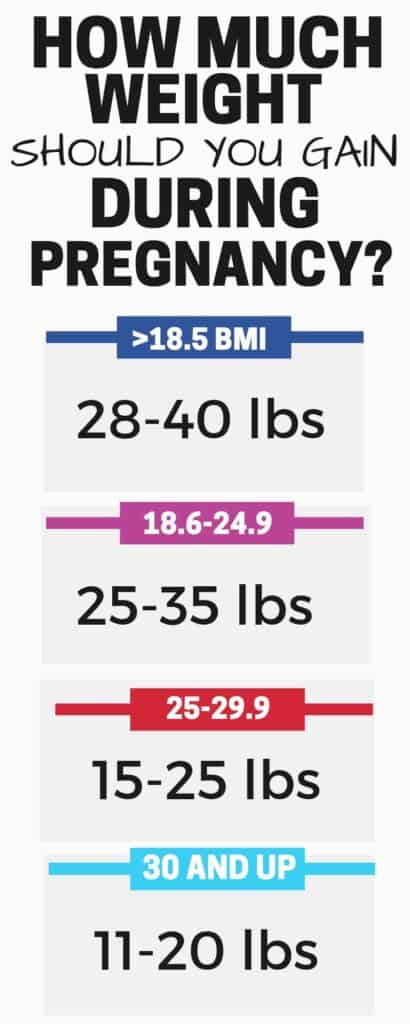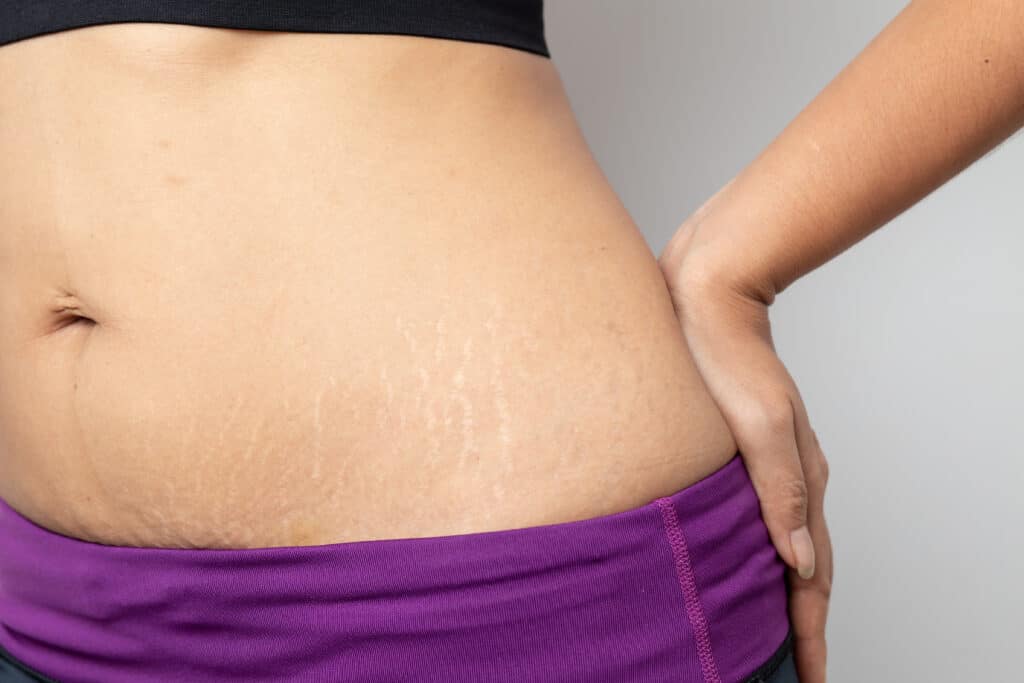
One of the most common questions pregnant women ask is about how to prevent stretch marks during pregnancy.
And while no cream or magic elixir has been proven to completely banish stretch marks from skin, there are things you can do to prevent stretch marks from appearing in the first place.
This post contains affiliate links. Read my policy here.
What are stretch marks and how do they form during pregnancy?
Stretch marks are very common in pregnancy; in fact, over 50% of women will get stretch marks during their first pregnancy. And most pregnant women will see stretch marks on their abdomen, hips, thighs and breasts.
Typically collagen and elastin fibers found in your skin allow it to stretch with ease- but in times of rapid weight gain, your skin just can’t keep up and stretch marks occur as a result.
Your elevated hormone level during pregnancy is also partly to blame, as an increased hormone level is said to reduce the bonds between collagen fibers, as well.
Are you guaranteed to get stretch marks during pregnancy?
No– just because you are pregnant doesn’t mean you’re guaranteed to get them. The study I outlined above observed that over 50% of women do get them– but what’s really interesting is how your age during pregnancy influences your chances of getting stretch marks.
A recent study found that women aged 20 or younger were more likely to develop stretch marks than those aged 30 or older.
In addition to age, genetics, weight gain during pregnancy and pre-pregnancy weight are all cited as risk factors for developing stretch marks.
When do stretch marks start in pregnancy?
Typically stretch marks make their unwelcome debut in the last few weeks of the second trimester or early in the third trimester.
How to prevent stretch marks during pregnancy
Here’s the good news in all this- despite any risk factors you may have towards developing stretch marks, there’s still a lot that can be done to minimize or prevent them from happening in the first place.
Your best bet towards preventing stretch marks is to follow these 6 simple guidelines:
1. Watch your weight gain
So now that we know stretch marks happen when the skin is stretched too rapidly, one of the best things you can do to prevent these scars and keep baby healthy and happy is to watch your weight gain during pregnancy.
And while I’m all too familiar with the cravings and insatiable hunger that come alongside pregnancy, it really helps to familiarize yourself with a few key tips to help curb the cravings and keep your weight in control.
Step 1: Find out how much weight you should gain
To figure out how much weight you should gain, first calculate your Body Mass Index (BMI).
Here’s a simple calculation to figure out your BMI:

Step 2: Find out how much weight you should gain based on your BMI:
Luckily you don’t have to guess how much weight you should gain during pregnancy, as ACOG spells this out pretty clearly:

2. Don’t gain weight too rapidly
Just like gaining too much weight can cause stretch marks, gaining weight too rapidly can also cause stretch marks.
You’ll want to keep a lot of healthy pregnancy snacks and meal ideas on hand to fight cravings and keep weight gain under control.
In your first trimester, it’s recommended that you gain no more than 4 pounds; in fact, some women report that they don’t gain nearly any weight at all due to loss of appetite.
Most of your weight gain comes during your second and third trimesters, where you’ll likely be gaining a pound per week.
Interestingly enough, your weight gain is likely to plateau later in the third trimester, as during this time the baby’s weight is picking up while yours is slowing.
According to ACOG, here’s how much weight you should gain each week in your second and third trimesters, based on your BMI:
| BMI | Weight gain per week in 2nd and 3rd trimesters (in lbs) |
| >18.5 | 1 |
| 18.6-24.9 | 1 |
| 25-29.9 | .6 |
| 30 and up | .5 |
3. Don’t drink too much caffeine
Too much caffeine and pregnancy don’t mix well, and surprisingly enough, excess caffeine has also been linked to an increase in stretch marks!
Aim to have no more than 200 mg per day, which is roughly 12 ounces. Don’t forget about things like chocolate and tea when calculating your total caffeine intake, too!
4. Drink enough water
Water helps your skin repair and rebuild, and adequate water is helpful in reducing stretch marks from forming.
A good rule of thumb when figuring out how much water to drink is to divide your weight in half and aim to drink that amount in ounces.
Naturally as you increase your weight during the second and third trimesters, you’ll need to drink more water.
Not only does enough water help to prevent stretch marks, but it’s also shown to reduce the effects of morning sickness, too!
5. Exercise to reduce the chances of getting stretch marks in pregnancy
Exercise has so many amazing benefits for pregnant women. Everything from a shorter labor, decrease in excess weight gain and easier postpartum recovery have been attributed to exercising during pregnancy.
Exercise also reduces the chances of stretch marks!
When you exercise your circulation is improved, which helps your skin to maintain a healthy balance–keeping it elastic and making it easier to be stretched without causing scars.
If that’s not enough to convince you, exercise also reduces the chances you’ll develop cellulite during pregnancy, too!
Once you obtain clearance from your doc, it’s recommended that you start out by doing about 30 minutes of moderate exercise three times a week.
You can work your way up to doing 30 minutes most days of the week, but to reap the full benefits of exercise during pregnancy make sure you stick to a consistent schedule.
Consistency is key to maintain a healthy weight gain and help prevent stretch marks and cellulite.
6. Eat foods that increase collagen levels in skin

Just like water intake plays a significant role in the health of your skin, the foods you ingest do too.
You can actually boost your body’s collagen production by eating certain foods.
Bone broth, chicken, fish, citrus fruits, leafy greens, tomatoes and bell peppers are all examples of foods that pack a punch with vitamins and minerals designed to elevate your body’s collagen production.
And since all of these foods are super healthy and typically found on many pregnancy diet lists, you’ll be eating healthy for baby and boosting your skin’s collagen levels at the same time!
Other questions you may have about stretch marks during pregnancy

What creams or oils are recommended to prevent stretch marks during pregnancy?
Unfortunately, there’s not really a ton of evidence pointing to the fact that creams or oils help to prevent stretch marks from occurring. (source)
There is however, tons of anecdotal evidence to suggest slathering a cream like Bio-Oil on each day helps.
From my personal experience I can attest to Bio Oil working to prevent stretch marks in my pregnancy, but I also tried to eat well, exercise and not gain weight too rapidly, too.
Can massages keep stretch marks from appearing?
Okay, good news, ladies! The answer to this one is yes!
Massage stimulates blood flow and is great for keeping your skin elastic–plus it’s a fantastic de-stresser for pregnant women!
For best results, use a cream like bio-oil when massaging the skin.
Will stretch marks fade or go away?
When stretch marks first appear they’re bright red in color, and after you deliver and begin to heal, stretch marks will typically fade to a translucent color and just look shiny.
Unfortunately, it is unlikely that they’ll completely disappear, though they will look significantly better.
Final thoughts on how to prevent stretch marks during pregnancy
Stretch marks in pregnancy are very common. Try not to stress about them and instead focus on how amazing your body is for creating and carrying a little life!
As with anything, an ounce of prevention goes a long way– maintaining a healthy weight, drinking plenty of fluids, eating foods that enhance your skin’s collagen levels and making sure to get regular exercise all work to help your skin stretch smoothly and gradually throughout your pregnancy.
Related pregnancy topics
Pregnancy essentials you can’t live without
Your ultimate third trimester to do list




Leave a Reply